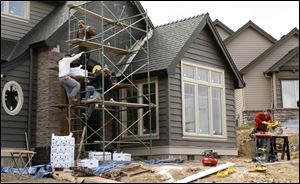
LAYOFFS DOWN; HOME BUILDING UP
Economy may be improving after slump in late spring
6/17/2011
Matthew Weisker holds his daughter, Lexi, 4, as he and his wife, Mindy, seek jobs in the Worksource Oregon database in Tualatin, Ore.
ASSOCIATED PRESS

Construction is under way on a home in Beaverton, Ore. Home construction rose last month to a seasonally adjusted annual rate of 560,000 units per year, according to the Commerce Department.
WASHINGTON -- Fewer Americans applied for unemployment benefits last week, and builders broke ground on more homes in May. The latest data offered some hope that the economy may be improving after hitting a slump in late spring.
Unemployment benefit applications fell to a seasonally adjusted 414,000, the Labor Department said Thursday. It was the second drop in three weeks and a positive sign that layoffs are slowing.
Still, applications have been above 400,000 for 10 straight weeks, evidence that the job market is weak compared to earlier this year.
Home construction rose last month to a seasonally adjusted annual rate of 560,000 units per year, the Commerce Department said. Economists say the pace of construction is far below the 1.2 million homes per year that must be built to sustain a healthy housing market. Many builders struggle to compete with low-priced foreclosures.
Unemployment applications had fallen in February to 375,000, a level that signals sustainable job growth. They stayed below 400,000 for seven of nine weeks. But applications surged in April to 478,000 -- an eight-month high -- and they have declined slowly since then.
Economists said the steady decline in unemployment applications signals that the job market is improving, but at a very slow pace.
"This is not a derailing of the economy," said Bricklin Dwyer, an economist at BNP Paribas. "This is a period of weak growth, and we're going to see this for some time."
The elevated level of applications suggests that companies pulled back on hiring in the face of higher gas and food prices, which have cut into consumer spending. Hiring has slowed sharply since applications rose.

Matthew Weisker holds his daughter, Lexi, 4, as he and his wife, Mindy, seek jobs in the Worksource Oregon database in Tualatin, Ore.
Employers added only 54,000 net new jobs in May, much slower than the average gain of 220,000 per month in the previous three months. The unemployment rate rose to 9.1 percent from 9 percent. Employers probably added more jobs in June than May, but less than the 220,000 earlier in 2011, economists said.
More hiring is important because it's key to boosting consumers' incomes, which in turn would fuel more spending. Consumer spending grew at a weak 2.2 percent annual rate in the January-March quarter, down from 4 percent in the previous quarter. That pushed down economic growth to 1.8 percent from 3.1 percent.
And some companies are cutting jobs. Johnson& Johnson said this week it will stop making some of its heart devices because of falling sales, a move that will eliminate up to 1,000 positions. And state and local governments are laying off thousands of employees in order to close large budget deficits.
While the job market was improving earlier this year, home building is coming off the two worst years on records dating back five decades. And the May data suggest that won't change anytime soon.
The number of single-family homes started in May rose a modest 3.7 percent. But the construction pace of single-family homes, which accounts for about 80 percent of residential construction, is well below the 2010 rate. Construction of those traditional homes is "very much dead in the water," said Mark Vitner, senior economist at Wells Fargo.
Housing permits, a gauge of future construction, rose last month to the highest level since December. But apartment and condominium construction accounted for a large portion of the rise. Renting is now a preferred option for many who lost their jobs in the recession and were forced to leave their rapidly depreciating homes.